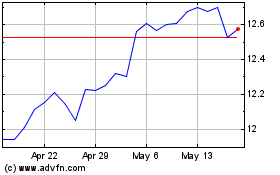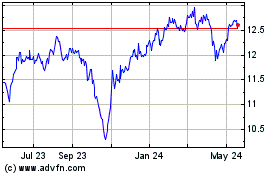Downey Announces Change in Previously Reported Non-Performing Assets
January 14 2008 - 6:00AM
PR Newswire (US)
NEWPORT BEACH, Calif., Jan. 14 /PRNewswire-FirstCall/ -- Downey
Financial Corp. (NYSE:DSL) announced today changes to previously
reported levels of non-performing assets. These changes pertain to
non-performing asset levels since June 30, 2007. Rick McGill,
President, commented, "As previously reported, we implemented at
the beginning of the third quarter of 2007 a borrower retention
program to provide qualified borrowers with a cost effective means
to change from an option ARM to a less costly financing
alternative. We contacted borrowers whose loans were current and we
offered them the opportunity to modify their loans into 5-year
hybrid ARMs or ARMs with interest rates that adjust annually but do
not permit negative amortization. The interest rates associated
with these modifications were the same or no less than those rates
afforded new borrowers but they were below the interest rates on
the original loans. We initially did not consider these
modifications of performing loans to be troubled debt
restructurings, as the modification was only made to those
borrowers who were current with their loan payments and the new
interest rate was no less than those offered new borrowers. KPMG
LLP, our independent registered public accounting firm, did not
object to this assessment during its third quarter review." Mr.
McGill continued, "During December 2007, KPMG advised us that upon
further review of the modification program, it was likely the loan
modifications should be recorded as troubled debt restructurings.
After reassessing our initial analysis, we determined these
modified loans should be accounted for as troubled debt
restructurings. This conclusion was reached because in the current
interpretation of GAAP, especially in the current housing market,
there is a rebuttable presumption that if the interest rate is
lowered in a loan modification, the modification is deemed to be a
troubled debt restructuring unless the modified loan can be proved
to be at a market rate of interest based upon new underwriting,
including an updated property valuation, credit report and income
analysis. We did not perform these additional steps since borrowers
who qualified for our retention program were current and we were
trying to streamline the process for qualified borrowers to modify
their loans at interest rates no less than that being offered to
new borrowers. Inasmuch as we chose not to perform these additional
measures, we are now required to make this reporting change and, as
such, our non- performing assets will increase from what has been
previously reported. While periods prior to the third quarter of
2007 are not impacted by this change, it will result in $99 million
of loans being classified as non-performing at September 30, 2007."
Brian Cote, Chief Financial Officer, commented, "As required for
all loans classified as troubled debt restructurings, loans
modified as part of our borrower retention program must now be
placed on non-accrual status but interest income will be recognized
when paid. If borrowers perform pursuant to the modified loan terms
for six months, the loans will be placed back on accrual status
and, while still reported as troubled debt restructurings, they
will no longer be classified as non-performing assets because the
borrower has demonstrated an ability to perform and the interest
rate was no less than those afforded new borrowers at the time of
the modification." Mr. Cote further commented, "We believe that
when loans modified under our borrower retention program are
current, it is relevant to distinguish them from total
non-performing assets because, unlike other loans classified as
non-performing assets, these loans are effectively performing at
interest rates no less than those afforded new borrowers.
Accordingly, when performing troubled debt restructurings are
excluded from the revised ratio of non- performing assets to total
assets, the revised ratio of all other non- performing assets to
total assets is not materially different from that previously
reported." The table below provides the revised ratio of
non-performing assets to total assets for each affected month of
2007, distinguishing from the total those troubled debt
restructurings associated with Downey's borrower retention plan
wherein the loans are current but have not yet established six
months of successful payment history so that they can be removed
from non-accrual status. Non-Performing Assets as Percent of Total
Assets Jun. 30, Jul. 31, Aug. 31, 2007 2007 2007 Revised Performing
Troubled Debt Restructuring (1) 0.00% 0.04% 0.31% Revised all Other
Non- Performing Assets 1.53% 1.77% 1.96% ----- ----- ----- Revised
Total 1.53% 1.81% 2.27% Previously Reported 1.53% 1.77% 1.96% Sep.
30, Oct. 31, Nov. 30, 2007 2007 2007 Revised Performing Troubled
Debt Restructuring (1) 0.67% 1.09% 2.05% Revised all Other Non-
Performing Assets 2.27% 2.77% 3.72% ----- ----- ----- Revised Total
2.94% 3.86% 5.77% Previously Reported 2.25% 2.74% 3.65% (1) Loans
modified pursuant to borrower retention plan where all loan
payments are current and the interest rate is no less than that
offered new borrowers. Mr. Cote concluded by stating, "As of
year-end 2007, the estimated level of non-performing assets as a
percent of total assets increased to 7.8%. Of this total, about 40%
represented modifications generated from our borrower retention
program, of which an estimated 95% have made all payments due.
Those performing troubled debt restructurings represent about 3.0%
of total assets. As yet, we have not determined the impact this
reporting change may have on previously reported financial
statements, if any, but we expect to complete this analysis soon."
Downey Financial Corp. is the parent company of Downey Savings and
Loan Association, F.A., with assets of $13.5 billion and 168
branches throughout California and four in Arizona. Certain
statements in this release may constitute "forward-looking
statements" under the Private Securities Litigation Reform Act of
1995, which involve risks and uncertainties. Forward-looking
statements do not relate strictly to historical information or
current facts. Some forward-looking statements may be identified by
use of terms such as "expects," "anticipates," "intends," "plans,"
"believes," "seeks," "estimates," or words of similar meaning, or
future or conditional verbs such as "will," "would," "should,"
"could" or "may." Downey's actual results may differ significantly
from the results discussed in such forward-looking statements.
Factors that might cause such a difference include, but are not
limited to, economic conditions, competition in the geographic and
business areas in which Downey conducts its operations,
fluctuations in interest rates, credit quality and government
regulation. Downey does not update forward-looking statements to
reflect the impact of circumstances or events that arise after the
date the forward- looking statements were made. DATASOURCE: Downey
Financial Corp. CONTACT: Brian E. Cote, CFO of Downey Financial
Corp., +1-949-509-4420 Web site: http://www.downeysavings.com/
Copyright
DoubleLine Income Soluti... (NYSE:DSL)
Historical Stock Chart
From Jun 2024 to Jul 2024

DoubleLine Income Soluti... (NYSE:DSL)
Historical Stock Chart
From Jul 2023 to Jul 2024
